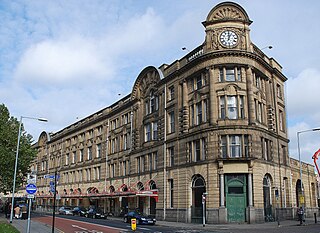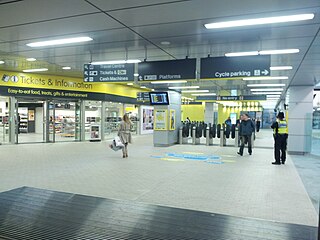
The Liverpool and Manchester Railway (L&MR) was the first inter-city railway in the world. It opened on 15 September 1830 between the Lancashire towns of Liverpool and Manchester in England. It was also the first railway to rely exclusively on locomotives driven by steam power, with no horse-drawn traffic permitted at any time; the first to be entirely double track throughout its length; the first to have a signalling system; the first to be fully timetabled; and the first to carry mail.

Manchester Victoria station in Manchester, England is a combined mainline railway station and Metrolink tram stop. Situated to the north of the city centre on Hunts Bank, close to Manchester Cathedral, it adjoins Manchester Arena which was constructed on part of the former station site in the 1990s. Opened in 1844 and part of the Manchester station group, Victoria is Manchester's third busiest railway station after Piccadilly and Oxford Road and the second busiest station managed by Northern after Oxford Road.

Edge Hill is a district of Liverpool, England, south east of the city centre, bordered by Kensington, Wavertree and Toxteth.

Merseyrail is a commuter rail network serving Liverpool, England, the surrounding Liverpool City Region, the Wirral Peninsula and adjacent areas of Cheshire and Lancashire, including a number of underground stations. The core of the network is formed by two dedicated electrified lines known as the Northern Line and the Wirral Line, which run underground in central Liverpool and Birkenhead. The third line, separate from the electrified network, is named the City Line. The City Line is a term used by the governing body Merseytravel referring to local Northern services it sponsors serving in its area operating on the Liverpool to Manchester Lines and Liverpool to Wigan Line. Many of the City Line stations are branded Merseyrail using Merseyrail ticketing.

Crown Street Station was a passenger railway terminal station on Crown Street, Liverpool, England. The station was the world's first intercity passenger station, opening in 1830, also being the railway terminal station for Liverpool. Used for passengers for only six years the station was demolished as the site was converted into a goods yard. The goods yard remained in use until 1972. The location of the station is now a park with little trace of the station or goods yard.

Wapping or Edge Hill Tunnel in Liverpool, England, is a tunnel route from the Edge Hill junction in the east of the city to the Liverpool south end docks formerly used by trains on Liverpool-Manchester line railway. The tunnel alignment is roughly east to west. The tunnel was designed by George Stephenson with construction between 1826 and 1829 to enable goods services to operate between Liverpool docks and all locations up to Manchester, as part of the Liverpool and Manchester Railway. It was the first tunnel in the world to be bored under a city. The tunnel is 2,030 metres (1.26 mi) long, running downhill from the western end of the 262 metres (0.163 mi) long Cavendish cutting at Edge Hill in the east of the city, to Park Lane Goods Station near Wapping Dock in the west. The Edge Hill portal is near the former Crown Street Station goods yard. The tunnel passes beneath the Merseyrail Northern Line tunnel approximately a quarter of a mile south of Liverpool Central underground station.

The Waterloo Tunnel in Liverpool, England, is a former railway tunnel, 852 yd (779 m) long, which opened in 1849. Its western end was at 53.414829, -2.994385, underneath Pall Mall. From here the line continued under Great Howard Street to Waterloo Goods railway station, now the site of the Kingsway Tunnel Ventilation Shaft, after 1895 continuing beyond to the dock railway system and on to Liverpool Riverside at the Pier Head for direct connection to the passenger liners. The eastern end opens into a short cutting, four tracks wide between Byrom Street and Fontenoy Street, which connects to the Victoria Tunnel, which emerges at Edge Hill station. It is effectively one long tunnel from Edge Hill to Liverpool Waterloo Dock with two names along its route. The tunnels were given two different names because initially trains in the Victoria Tunnel were cable hauled and in the Waterloo Tunnel locomotive hauled. Both tunnels closed on 19 November 1972.

Edge Hill railway station serves the district of Edge Hill, Liverpool, England.

The Port of Liverpool is the enclosed 7.5 miles (12.1 km) dock system that runs from Brunswick Dock in Liverpool to Seaforth Dock, Seaforth, on the east side of the River Mersey and the Birkenhead Docks between Birkenhead and Wallasey on the west side of the river. The port was extended in 2016 by the building of an in-river container terminal at Seaforth Dock, named Liverpool2. The terminal can berth two 14,000 container Post-Panamax ships.

Manchester Dock was a dock on the River Mersey in England and a part of the Port of Liverpool. The dock was not part of the interconnected dock system, but was connected directly to the river.

A tram-train is a light-rail public transport tram vehicles running through from an urban tramway network to main-line railway lines which are shared with conventional trains. This combines the tram's flexibility and accessibility with a train's greater speed, and bridges the distance between main railway stations and a city centre.

Liverpool Central railway station in Liverpool, England, forms a central hub of the Merseyrail network, being on both the Northern Line and the Wirral Line. The station is located underground on two levels, below the site of a former mainline terminus. It is the busiest station in Liverpool, though considerably smaller than Lime Street station, the mainline terminus, and the busiest station to operate fully the Merseyrail network. The station is the busiest underground station outside London serving 40,000 people daily. The station in passengers per platform is the busiest underground railway station in the United Kingdom at 5,217,547 per platform per annum and laying third in all stations, underground or overground.

Merseytram was a proposed light rail system for Merseyside, England. Originally proposed in 2001, forming part of the Merseyside Local Transport Plan, it was to consist of three lines, connecting the Metropolitan Borough of Knowsley with central Liverpool. The project was postponed due to funding problems before eventually being formally closed down by Merseytravel in October 2013.

There once were four direct railway routes between Liverpool and Manchester in the North West of England; only two remain, the two centre routes of the four. The most northerly and the most southerly of the four routes are no longer direct lines. Of the remaining two direct routes, the northern route of the two is fully electric, while the now southern route is a diesel-only line. The most northerly of the four has been split into two routes: the western section operated by Merseyrail electric trains and the eastern section by diesel trains, requiring passengers to change trains between the two cities. The fourth route, the most southerly of the four, has been largely abandoned east of Warrington; the remaining section caters mainly for freight trains.
The North Liverpool Extension Line was a railway line in Liverpool, England in operation between 1879 and 1972. It was at one stage intended to become the eastern section of the Merseyrail Outer Loop, an orbital line circling the city.

The Canada Dock Branch is a 4-mile 59 chain long railway line in Liverpool, England. The line's route is from the large Edge Hill rail junction in the east of Liverpool to Seaforth Dock to the north. The line was originally built by the London and North Western Railway terminating at Canada Dock, with a later branch extension added to Alexandra Dock and links onto the MDHC railway lines. The line is not electrified.
The City Line is the name given to local and regional stopping rail services out of the main line platforms of Liverpool Lime Street railway station. It appears on some maps of the Merseyrail network as red, and covers the Liverpool–Wigan line, the two routes of the Liverpool–Manchester lines, the Liverpool-Crewe Line, Liverpool-Chester line via Runcorn and the Liverpool-Blackpool line.

The Victoria Tunnel in Liverpool, England is a 1.537 miles (2.474 km) long rail tunnel. Opened in 1849, its eastern portal is adjacent to Edge Hill station. The western portal opens into a short cutting, between Byrom Street and Fontenoy Street, the shorter Waterloo Tunnel exits the cutting terminating at Waterloo Dock. The Victoria and Waterloo tunnels are effectively one long tunnel connected by a ventilation cutting. The whole length is generally known as the Waterloo Tunnel.
Liverpool in North West England, is a major British city with significant road, rail, and ferry networks, in addition to an international airport and a well-known dock system. As with most other major UK cities, Liverpool's transport infrastructure is centred on its road and rail networks. Public transport services within the city are controlled and run by Merseytravel.

Liverpool city centre is the commercial, cultural, financial and historical centre of Liverpool, England.


















